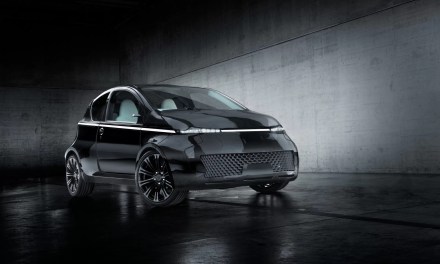Hyundai Motor Group’s New Horizon Studio advanced development group unveiled its new TIGER (Transforming Intelligent Ground Excursion Robot), the company’s second Ultimate Mobility Vehicle (UMV) and the first designed to be operated without an onboard pilot or passengers—“uncrewed,” as the company put it. TIGER is designed to carry various types of payload while traveling over challenging terrain, either by rolling across it or walking over it.
Formed in September 2020, the New Horizons Studio is focused on the development of UMVs, vehicles with unprecedented mobility. The products will target customers who have a need for travel in unconventional and off-road terrain, including places where vehicles have never roamed before. These vehicles will be subject to more challenging applications and environments, adaptable to changing conditions.
New Horizons Studio is led by Vice President Dr. John Suh, who has held several leadership roles at Hyundai Motor Group since 2011. He served as founding director for both Hyundai Ventures and CRADLE (Center for Robotic-Augmented Design in Living Experiences) in Silicon Valley. His over 35 years of expertise in the automotive and emerging technology sectors includes roles at Stanford University, Palo Alto Research Center (PARC; formerly, Xerox PARC), and General Motors Co.
Also making the jump to New Horizons Studio is Dr. Ernestine Fu, who joins the group as Director of Product Management. She previously led research on human-operator and autonomous-vehicle interactions at Stanford University’s Volkswagen Automotive Innovation Lab, as well as scaled emerging technology companies for over nine years as a venture capital partner at Alsop Louie Partners.
Unveiled at CES 2019, the Hyundai Elevate is the inaugural vehicle concept being developed by New Horizons Studio. The vehicle is expected to address challenging driving situations. For example, a car with robotic legs could save lives as the first responder in natural disasters, or people who do not have access to an ADA ramp could hail a car to walk up to their front door, level itself, and allow wheelchairs to roll in. Using a combination of robotics and wheeled locomotion technology, Elevate and other vehicles by New Horizons Studio are expected to redefine vehicular mobility.
The first version of Hyundai’s new concept, TIGER X-1 (X stands for experimental), measures about 31 in (787 mm) long and 16 in (406 mm) wide, without its legs extended. A follow-up to the Elevate walking vehicle concept introduced from CES 2019, the new autonomous, electric, all-wheel-drive vehicle is designed to function as a mobile scientific exploration platform, delivery vehicle, or an emergency response tool in extreme, remote locations. Based on a modular platform architecture, it features include a sophisticated leg and wheel locomotion system, 360-degree directional control, and a range of sensors for remote observation. Weighing only 26 lb (12 kg), TIGER X-1 is also intended to connect to unmanned aerial vehicles (UAVs), which can fully charge and deliver it to inaccessible locations.
A large load bay within its body means the vehicle can carry goods for delivery, or be deployed to deliver aid packages in emergency situations. Leg-wheel articulation allows it to walk over obstacles, using its wheels as feet and enables TIGER X-1 to tackle a range of extreme situations while keeping payloads more level than a typical ground vehicle.
Suh cited Hyundai’s long-term strategy to become “a smart mobility provider” as one of the driving forces behind the development of the TIGER concept.
“We recognize the opportunities presented by new technologies and new business models,” said Suh. “We also recognize the importance of understanding the changing needs of current and future customers.
“Vehicles like TIGER, and the technologies underpinning it, give us an opportunity to push our imaginations,” Suh continued. “We are constantly looking at ways to rethink vehicle design and development and re-define the future of transportation and mobility.”
Hyundai and New Horizon Studio led the TIGER project but also engaged some key partners to bring the concept to life as part of its open innovation approach to development.
“One of our partnerships is with Autodesk,” said Suh. “Tiger X-1 fuses Autodesk’s design and manufacturing expertise with Hyundai’s R&D capabilities in new mobility. Our teams have worked together to create lightweight but strong structures. The legs, wheels, chassis, and even its tires have been designed for additive manufacturing.”
New Horizon Studio also partnered with Sundberg-Ferar, a product-innovation and concept-design firm in Michigan.
“While developing TIGER with New Horizons Studio, the team at Sundberg-Ferar was looking to create a robot that maximized the efficiency of wheeled motion with the articulation of a quadruped to expand the possibility of reaching more remote locations,” said David Byron, Manager of Design and Innovation Strategy at Sundberg-Ferar. “TIGER is a modular platform design allowing different bodies to be attached to the chassis for unique applications such as cargo delivery or surveillance in locations not suitable for humans.”
Hyundai Motor Group posted a video demonstrating the capabilities of TIGER X-1 on its YouTube channel.


















































































